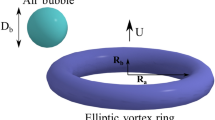Abstract
Numerical simulations are used to study laminar vortex ring formation under the influence of background flow. The numerical setup includes a round-headed axisymmetric body with an opening at the posterior end from which a column of fluid is pushed out by a piston. The piston motion is explicitly included into the simulations by using a deforming mesh. A well-developed wake flow behind the body together with a finite-thickness boundary layer outside the opening is taken as the initial flow condition. As the jet is initiated, different vortex evolution behavior is observed depending on the combination of background flow velocity to mean piston velocity (\(U/U_{p}\)) ratio and piston stroke to opening diameter (\(L_{m}/D\)) ratio. For low background flow (\(U/U_{p} =0.2\)) with a short jet (\(L_{m}/D =6\)), a leading vortex ring pinches off from the generating jet, with an increased formation number. For intermediate background flow (\(U/U_{p} =0.5\)) with a short jet (\(L_{m}/D =6\)), a leading vortex ring also pinches off but with a reduced formation number. For intermediate background flow (\(U/U_{p} =0.5\)) with a long jet (\(L_{m}/D =15\)), no vortex ring pinch-off is observed. For high background flow (\(U/U_{p} =0.75\)) with both a short (\(L_{m}/D =6\)) and a long (\(L_{m}/D =15\)) jet, the leading vortex structure is highly deformed with no single central axis of fluid rotation (when viewed in cross-section) as would be expected for a roll-up vortex ring. For \(L_{m}/D =6\), the vortex structure becomes isolated as the trailing jet is destroyed by the opposite-signed vorticity of the background flow. For \(L_{m}/D =15\), the vortex structure never pinches off from the trailing jet. The underlying mechanism is the interaction between the vorticity layer of the jet and the opposite-signed vorticity layer from the initial wake. This interaction depends on both \(U/U_{p}\) and \(L_{m}/D\). A comparison is also made between the thrust generated by long, continuous jets and jet events constructed from a periodic series of short pulses having the same total mass flux. Force calculations suggest that long, continuous jets maximize thrust generation for a given amount of energy expended in creating the jet flow. The implications of the numerical results are discussed as they pertain to adult squid propulsion, which have been observed to generate long jets without a prominent leading vortex ring.
Similar content being viewed by others
References
Anderson, E.J., DeMont, M.E.: The mechanics of locomotion in the squid Loligo pealei: locomotory function and unsteady hydrodynamics of the jet and intramantle pressure. J. Expl Biol. 203, 2851 –2863 (2000)
Anderson, E.J., Jiang, H., Grosenbaugh, M.A.: Jet flow in swimming squid. Am. Zool. 41, 1380–1381 (2001)
Anderson, E.J., Grosenbaugh, M.A.: Jet flow in steadily swimming adult squid. J. Expl. Biol. 208, 1125–1146 (2005)
Bartol, I.K., Patterson, M.R., Mann, R.: Swimming mechanics and behavior of the shallow-water brief squid Lolliguncula brevis. J. Expl. Biol. 204, 3655–3682 (2001)
Didden, N.: On the formation of vortex rings: rolling-up and production of circulation. J. Appl. Math. Phys. (ZAMP) 30, 101–116 (1979)
Demirdzic, I., Peric, M.: Finite volume method for prediction of fluid flow in arbitrarily shaped domains with moving boundaries. Int. J. Num. Methods in Fluids 10, 771–790 (1990)
Gharib, M., Rambod, E., Shariff, K.: A universal time scale for vortex ring formation. J. Fluid Mech. 360, 121–140 (1998)
Heeg, R.S., Riley, N.: Simulations of the formation of an axisymmetric vortex ring. J. Fluid Mech. 339, 199–211 (1997)
Krueger, P.S., Dabiri, J.O., Gharib, M.: Vortex ring pinchoff in the presence of simultaneously initiated uniform background co-flow. Phys. Fluids 15, L49–L52 (2003)
Linden, P.F., Turner, J.S.: The formation of ‘optimal’ vortex rings, and the efficiency of propulsion devices. J. Fluid Mech. 427, 61–72 (2001)
Mohseni, K., Gharib, M.: A model for universal time scale of vortex ring formation. Phys. Fluids 10, 2436–2438 (1998)
Mohseni, K., Ran, H., Colonius, T.: Numerical experiments on vortex ring formation. J. Fluid Mech. 430, 267–282 (2001)
O'Dor, R.K.: The forces acting on swimming squid. J. Expl. Biol. 137, 421–442 (1988)
Panton, R.L.: Incompressible Flow, pp. 837. Wiley, New York (1996)
Rosenfeld, M., Rambod, E., Gharib, M.: Circulation and formation number of laminar vortex rings. J. Fluid Mech. 376, 297–318 (1998)
Shariff, K., Leonard, A.: Vortex rings. Ann. Rev. Fluid Mech. 34, 235–279 (1992)
Siekmann, J.: On a pulsating jet from the end of a tube, with application to the propulsion of certain aquatic animals. J. Fluid Mech. 15, 399–418 (1963)
Weihs, D.: Periodic jet propulsion of aquatic creatures. Fortschr. Zool. 24, 171–175 (1977)
Zhao, W., Frankel, S.H., Mongeau, L.G.: Effects of trailing jet instability on vortex ring formation. Phys. Fluids 12, 589–596 (2000)
Author information
Authors and Affiliations
Additional information
Communicated by R. D. Moser
PACS 02.60.Cb, 47.32.cf, 47.32.cb, 47.20.Ft, 47.63.M-
Rights and permissions
About this article
Cite this article
Jiang, H., Grosenbaugh, M.A. Numerical simulation of vortex ring formation in the presence of background flow with implications for squid propulsion. Theor. Comput. Fluid Dyn. 20, 103–123 (2006). https://doi.org/10.1007/s00162-006-0010-5
Received:
Revised:
Accepted:
Published:
Issue Date:
DOI: https://doi.org/10.1007/s00162-006-0010-5




